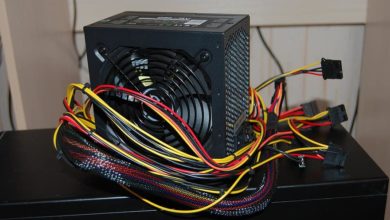Virtual reality or VR is no longer the future, it’s here, and there are loads of VR headsets on the market that you can get your hand on and nowadays, even at affordable prices.
It’s making VR a more commonly used platform by the day, but the problem that you might find, at least if you’re a PC gamer, is that you need a pretty decent graphics card in order to have it run without any issues.
Better hardware, better experience. Keeping reading our buying guide & top product choices to find out more.
- What is VR & how does it work?
- Why does VR need a high-quality graphics card?
- What graphics card is recommended for VR?
- Finding a VR ready GPU
- Beware of VR sickness
- Best budget graphics card for VR
- Best mid-range graphics card for VR
- Best high-spec graphics card for VR
- Best overall graphics card for VR
What is VR & how does it work?
Virtual reality (VR) is exactly what it says on the tin, using unique displays and cutting edge tech to create an experience that you can really immerse yourself in, through a combination of all of your senses.
The VR application will feel like it surrounds you, putting the headset on should combine sight, sound, touch to the point that you feel like you are fully immersed within the gameplay itself.
As it develops there are several games new and old that are being made for the sole purpose of VR, one of the biggest breakthroughs was the redesign of Skyrim, a very popular video game, which was configured to work on PC and run through VR. If you’ve ever played Skyrim, you might realise why this is one of the best choices to showcase VRs initial capabilities.
VR links the game to your actions, you duck when the dragon breathes fire, and your character will do the same, you swing your sword, your character will do the same.
It’s not just games though, you can get movies, TV shows and more that are specifically designed for VR and to make it feel like you are actually in the film itself with a 360 view.
The possibilities are pretty endless, but how does it actually work? The headset will use either two LCD displays or two feeds sent to a single LCD display (one per each eye). These are connected by lenses between your two eyes so that no gaps can be seen.
These lenses will create a stereoscopic 3d image by reshaping the picture for each eye as each eye acts differently. To really see the genius technology required in a VR headset, close one of your eyes when you have it on and you’ll see what we mean.
Why does VR need a high-quality graphics card?
You might be wondering why we’ve even written this post, why do you need to consider your graphics card options when it comes to building your VR PC? Well VR, as you might imagine, can be quite graphically demanding, so it’s important that you put a graphics card that can cope with that and not let down the rest of the PC.
It’s recommended that you have a minimum of a NVIDIA GTX 970 which as an example is retailing at $250-260 on Amazon currently (example) or a AMD R9 390. These are quite obviously dated cards in 2020, so you can often find a lot more powerful and cheaper options on the market, which we’ll explore later.
It’s also worth mentioning that you need to have a decent quality CPU as well, which is recommended to be an i5-4590 at the very minimum.
What graphics card is recommended for VR?
As with anything tech-based, graphics card are forever changing so I wouldn’t want to say definitely which is the best graphics card for VR at the given time you’re looking, however, there’s a good way of finding out the best deal.
The NVIDIA GTX 970 which I mentioned above as the minimum graphics requirement for VR is benchmarked by PassMark Software at 622,940, so anything higher than this that is VR ready should do.
The best thing to do for research purposes is to go somewhere like Amazon.com and search for VR ready graphics cards, which will provide you with several suitable graphics cards which you can then check the benchmark stats for.
As an example, for under $200 is the current best seller, XFX Radeon RX 580 GTS XXX, which benchmarks at 502,646.
Finding a VR ready GPU
It’s relatively easy to find a VR compatible graphics card nowadays since the technology has been readily available for a few years now. That means that you can always find a competitive deal, and even some of the budget options are more than capable of running VR.
We’ll go through our research & and pick out some of the best graphics cards for VR for you later in the article.
Beware of VR sickness
This is another thing to be wary of when using VR. Although it’s been around for a long time, it’s really become a staple of the gamers home in recent years with several new & competitively priced products coming to the market.
It’s enjoyable, but some of the early versions of the software put a lot of people off, as the term “VR Sickness” became very prominent. It’s not so common now, but with cheaper versions of headsets or older generations, you might feel a bit of nausea whilst playing.
How does this relate to graphics card you might ask? Well, a lot of people seem to have the impression that if they experience VR sickness that it might be because of their graphics card and the quality of it. You don’t just have to jump into buying a new GPU though, because it’s not the issue, it’s more likely your headset or even a poorly developed VR game.
Best budget graphics card for VR
If you’re looking at graphics cards for VR but don’t have the budget to go for something a little bit more on the expensive side, not to worry, as we’ve mentioned there are several GPU’s out there at very reasonable prices that will do the job. Here are just a few of the best:
VR Graphics Cards Under $150
MSI Gaming GeForce GTX 1650 128-Bit HDMI/DP/DVI 4GB GDRR6 HDCP Support DirectX 12 VR Ready OC Graphics Card (GTX 1650 D6 Ventus XS OC)
Product Description:
This GPU is designed to suit any build and is the perfect Ultra High resolution for your VR needs. It’s at a very cheap price point for a VR ready graphic card and it obviously carries the MSI trusted brand name. It’s got a crisp and sharp image when gaming. It’s also designed to transfer heat efficiently with its aluminum heat sink. It also comes with Afterburner, MSI’s own, well recognized and known overclocking software.
Features:
- MSI
- Output: HDMI, DVI & Display Port
- Nvidia chipset
- 4GB GDDR6 RAM
- Boosts to 1620 MHz
- 128 bit memory interface
VR Graphics Cards Under $200
XFX Radeon RX 580 GTS XXX Edition 1386MHz OC+, 8GB GDDR5, VR Ready, Dual BIOS, 3xDP HDMI DVI, AMD Graphics Card
Product Description:
This XFX graphics card is part of the RX 580 series which has the latest architecture by Polaris, with graphics cores 4th gen GCN. It also has new multimedia cores, with a new display engine and also features revolutionary tech with enhanced performance and efficiency.
It has a minimum power req of 500W, and can clock 8GHz (8.1GHz boosted OC+), it also comes with advanced cooling technology to ensure it doesn’t overheat. The GPU also offers several overclocking settings for advanced performance, with a true clock of 1366MHz and 1386 MHz OC+.
This product also is VR ready and allows you to experience the compelling world of VR with just about any headset, offering lag free performance with it’s AMD LiquidVR technology.
Features:
- XFX
- 8GB Memory
- 500W power required
- XFX True clock technology
- OC+ Capable
- Enhanced VRM & Memory cooling
VR Graphics Cards Under $250
ASUS Radeon RX 580 O4G Dual-Fan OC Edition GDDR5 DP HDMI DVI VR Ready AMD Graphics Card
Product Description:
This is a fantastic graphics card by Asus, the dual fan RX580 is perfect for your VR needs with it’s one click overclocking functionality. It also features something they refer to as Auto Extreme manufacturing tech, which essentially ensures that it’s reliable and premium, it also has a dual fan system to keep it quieter and most importantly cooler whilst coming.
The card itself features two HDMI ports so it’s perfect for a VR connection, without having to swap any cables around every single time. It also comes with some great tech such as the wing blade design to maximize airflow and allows it to operate about 3x quieter than comparable cards. There’s also something called the GPU Tweak 2, which allows the adjustment of fan, voltage and clock speeds.
Features:
- Built specifically for VR
- Boost to 1380MHz
- Two HDMI ports for VR devices
- Dual fan cooling with patented design
- GPU Tweak 2 tech
- Auto-Extreme technology
Best mid-range graphics card for VR
ASUS GeForce RTX 2060 Overclocked 6G GDDR6 Dual-Fan EVO Edition VR Ready HDMI DisplayPort DVI Graphics Card
Product Description:
This ASUS product, powered by NVIDIA, is a fantastic mid range graphics card perfect for VR. It offers a 1785MHz boost clock, a 6GB GDDR6 memory and 1920 CUDA cores, for the price point, it’s a fantastic buy.
It has the Wing Blade fans with dust resistance, which also allows it to run almost silently and keeps it cool with temperatues below 55C. There is also an aluminum backplate which prevents any damage to the PCB and ensures durability. Like the other ASUS option in our list, it comes with GPU Tweak 2 making it easy to monitor performance in game.
All in, it’s a fantastic, silent, cool, overclockable GPU that is going to run your VR with very little trouble.
Features:
- DirectX 12
- ASUS
- DisplayPort, DVI & HDMI options
- NVIDIA Chipset
- 6GB GDDR6
- VR Ready
Best high-spec graphics card for VR
Gigabyte GeForce GTX 1080 G1 Gaming 8GB GDDR5X VR Ready WINDFORCE 3X Cooling System Graphics Card
Product Description:
This graphics card is a beast, powered by GeForce it has an integrated memory of 8GB GDDR5X 256bit memory. It features a Windforce 3x blade fan designed by Gigabye to ensure optimum temperatures and quiet running. It of course supports VR which is why it’s made it into this post, but it also allows up to 8k display at 60Hz, which is fantastic.
It’s pretty as well, with it’s 16.8M customizable color RGB lighting, so if you have an open case, it doesn’t look half bad! It’s the ulimate graphics card and you won’t be disappointed with the performance delivery from the GTX 10 series.
Features:
- 8K ready
- 8GB GDDR5
- One click super overcloking
- GPU Gauntlet sorting
- Stylish metal back plate
- Customizable lighting
- Heat pipe direct touch
- Windforce 3x Cooling system
- Aorus Graphics engine
Best overall graphics card for VR
MSI Gaming GeForce GTX 1660 Ti 192-bit HDMI/DP 6GB GDRR6 HDCP Support DirectX 12 Dual Fan VR Ready OC Graphics Card
Product Description:
Now for the best overall graphics card to make the list, the MSI GeForce GTX 1660 TI. It’s an afforable 6GB GDRR6, DirectX 12, dual fan, VR ready device, that will be more than capable of running all your VR gaming needs.
It has 3x displayport outputs and one HDMI port, a steep curved blade for accelerating airflow to keep it cool and quiet, you can wirelessly control it thorugh your Android or iOS devices, allows ingame recording and most importantly will give you a tear free and smooth gameplay as it has a refresh rate of up to 240Hz!
It’s all you’ll ever need from a GFX for VR and it’s not too expensive either.
Features:
- Reliable MSI brand
- Boost clock of 1830MHz
- Core clocks 1770MHz
- 6GB GDDR6
- 3x Displayport & 1x HDMI
- 120w power consumption = 450W recommended PSU
- Nvidia chipset




